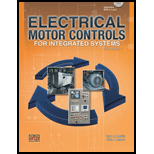
Electrical Motor Controls for Integrated Systems
5th Edition
ISBN: 9780826912268
Author: Gary Rockis;Glen A. Mazur
Publisher: American Technical Publishers
expand_more
expand_more
format_list_bulleted
Question
Chapter 2.2, Problem 4CP
To determine
To explain: The electrical device is used to provide both start and stop includes overload protection to motor.
Expert Solution & Answer
Want to see the full answer?
Check out a sample textbook solution
Students have asked these similar questions
Don't use ai to answer I will report you answer
Q1: What is the orientation of voltage regulation value (positive or negative) of
alternator loaded by capacitive load? Explain the effect of armature reaction on
voltage regulation for this load? Draw the load characteristics of alternator for
capacitive, inductive, and inductive loads?
I what happend if can
IY = 125 lead, IB = 125 unity
IR=89.91 unity
IB = 125-> Lag 0.8
Iy=125
IB
36.86
lag 0.8
Ir<
36-86
IN=IR+IN+IB
FR
89.910+125<-120-36.86+1252+120
-36.86
Chapter 2 Solutions
Electrical Motor Controls for Integrated Systems
Knowledge Booster
Learn more about
Need a deep-dive on the concept behind this application? Look no further. Learn more about this topic, electrical-engineering and related others by exploring similar questions and additional content below.Similar questions
- Manual solution only, no Al usedarrow_forwardLook up the dislocation-induced energy levels in silicon and GaAs - cite your sources. a. Sketch them in the band gap. b. When are each of them most active? c. Are dislocations more detrimental in Si or GaAs? d. What is the threshold of dislocation density that each semiconductor can handle?arrow_forwardQ1: In a material for which o 9 s/m and e, -4, the electric field intensity E = 50 sin 8*10'1 V/m. Find: a. The conduction and displacement current densities. b. The frequency at which the conduction current is half the displacement current.arrow_forward
- Q2: The circular loop conductor lies in the Z-0 plane, has a radius of 40 cm and a resistance of 40 Q. Given B-0.9 sin 5°10' ta, Determine a. The induced voltage b. Currentarrow_forwardQW= 2x + y²+2z, x-In(). y= r² + In(rs) and z = 2r. Find W, and W,arrow_forwardQ1: F(x,y) ycosiy) + xe Find: fe-fry-fy and farrow_forward
- Q: f(x,y)=peasly)+xer Find: fxzfyy fry, and fyx Xcosyarrow_forwardFind the direction at which the directional derivative of f(x,y) = x² + sin(xy) at (1.0) has the value of 1.arrow_forwardUsing the table below, design a third (3th) order Butterworth HPF with a 4 KHz cutoff frequency. What is the additional stage required to HPF to design a third order BPF. Explain your answe Order Stage poles DF 2 stage poles 3 stage DF poles DF 1 1 Optional 2 1.414 3 י 1 1 2 1.848 2 0.765 5 2 1 1.618 1 0.618 6 2 1.932 1.414 2 0.518arrow_forward
- .I need the correct answer, and if it's wrong, please fix it 7. The midrange voltage gain of an amplifier is 100. The input RC circuit has a lower critical frequency of 1 kHz. The actual voltage gain at f-100 Hz is 100. 10. In a high-pass filter, the roll-off region occurs above the critical frequency.arrow_forwardSolve this problem and show all of the workarrow_forwardDon't use ai to answer I will report you answerarrow_forward
arrow_back_ios
SEE MORE QUESTIONS
arrow_forward_ios
Recommended textbooks for you
 Introductory Circuit Analysis (13th Edition)Electrical EngineeringISBN:9780133923605Author:Robert L. BoylestadPublisher:PEARSON
Introductory Circuit Analysis (13th Edition)Electrical EngineeringISBN:9780133923605Author:Robert L. BoylestadPublisher:PEARSON Delmar's Standard Textbook Of ElectricityElectrical EngineeringISBN:9781337900348Author:Stephen L. HermanPublisher:Cengage Learning
Delmar's Standard Textbook Of ElectricityElectrical EngineeringISBN:9781337900348Author:Stephen L. HermanPublisher:Cengage Learning Programmable Logic ControllersElectrical EngineeringISBN:9780073373843Author:Frank D. PetruzellaPublisher:McGraw-Hill Education
Programmable Logic ControllersElectrical EngineeringISBN:9780073373843Author:Frank D. PetruzellaPublisher:McGraw-Hill Education Fundamentals of Electric CircuitsElectrical EngineeringISBN:9780078028229Author:Charles K Alexander, Matthew SadikuPublisher:McGraw-Hill Education
Fundamentals of Electric CircuitsElectrical EngineeringISBN:9780078028229Author:Charles K Alexander, Matthew SadikuPublisher:McGraw-Hill Education Electric Circuits. (11th Edition)Electrical EngineeringISBN:9780134746968Author:James W. Nilsson, Susan RiedelPublisher:PEARSON
Electric Circuits. (11th Edition)Electrical EngineeringISBN:9780134746968Author:James W. Nilsson, Susan RiedelPublisher:PEARSON Engineering ElectromagneticsElectrical EngineeringISBN:9780078028151Author:Hayt, William H. (william Hart), Jr, BUCK, John A.Publisher:Mcgraw-hill Education,
Engineering ElectromagneticsElectrical EngineeringISBN:9780078028151Author:Hayt, William H. (william Hart), Jr, BUCK, John A.Publisher:Mcgraw-hill Education,

Introductory Circuit Analysis (13th Edition)
Electrical Engineering
ISBN:9780133923605
Author:Robert L. Boylestad
Publisher:PEARSON

Delmar's Standard Textbook Of Electricity
Electrical Engineering
ISBN:9781337900348
Author:Stephen L. Herman
Publisher:Cengage Learning

Programmable Logic Controllers
Electrical Engineering
ISBN:9780073373843
Author:Frank D. Petruzella
Publisher:McGraw-Hill Education

Fundamentals of Electric Circuits
Electrical Engineering
ISBN:9780078028229
Author:Charles K Alexander, Matthew Sadiku
Publisher:McGraw-Hill Education

Electric Circuits. (11th Edition)
Electrical Engineering
ISBN:9780134746968
Author:James W. Nilsson, Susan Riedel
Publisher:PEARSON

Engineering Electromagnetics
Electrical Engineering
ISBN:9780078028151
Author:Hayt, William H. (william Hart), Jr, BUCK, John A.
Publisher:Mcgraw-hill Education,
Types of Protective Relays and Design Requirements, Part 1a.; Author: GeneralPAC: Power System Tutorials;https://www.youtube.com/watch?v=JYil4T5VSDM;License: Standard Youtube License